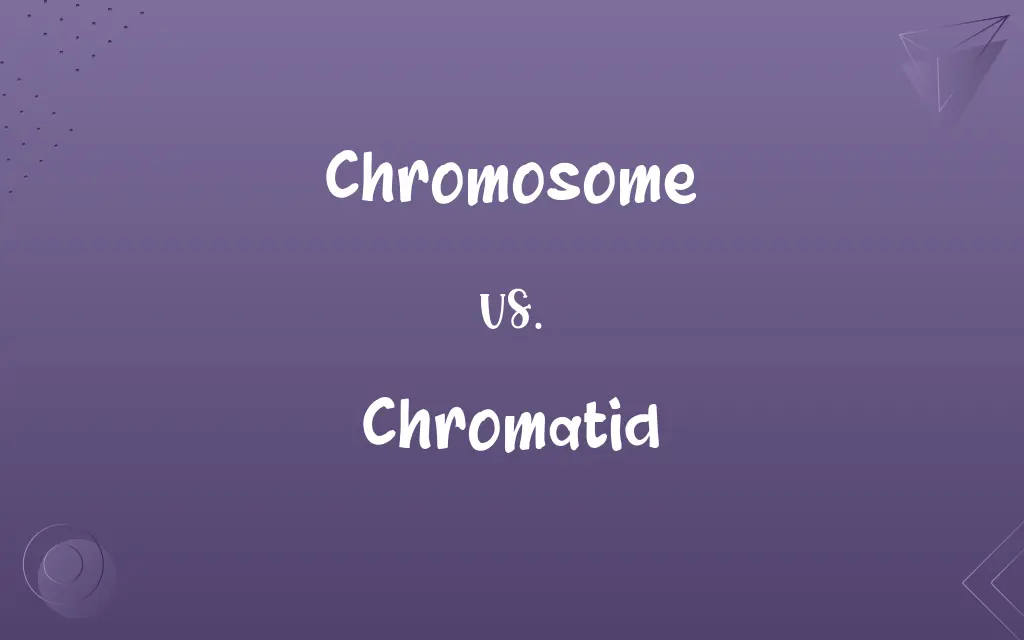Chromosome vs. Chromatid: Know the Difference

By Shumaila Saeed || Updated on December 25, 2023
Chromosome is a structure made of DNA and proteins; contains genes. Chromatid is one half of a duplicated chromosome.

Key Differences
A chromosome is a long DNA molecule with part or all of the genetic material of an organism. Chromatids are identical strands of chromosomes formed during DNA replication.
Shumaila Saeed
Dec 18, 2023
Chromosomes are located in the nucleus of eukaryotic cells and vary in number and shape among different organisms. Each chromatid, after DNA replication, is part of a chromosome and is joined to its sister chromatid at a region known as the centromere.
Shumaila Saeed
Dec 18, 2023
During cell division, chromosomes ensure the accurate transfer of genetic information to new cells. A chromatid refers specifically to the duplicated strands of a chromosome that are visible during certain phases of cell division.
Shumaila Saeed
Dec 18, 2023
The structure of a chromosome changes through the cell cycle; they are most visible during mitosis. Each chromatid is one of the two identical halves of a replicated chromosome.
Shumaila Saeed
Dec 18, 2023
Geneticists study chromosomes to understand heredity and genetic disorders. Chromatids are critical in the study of genetics as they represent the replicated state of chromosomes before cell division.
Shumaila Saeed
Dec 18, 2023
ADVERTISEMENT
Comparison Chart
Definition
A DNA molecule containing genetic information.
One half of a duplicated chromosome.
Shumaila Saeed
Dec 18, 2023
Role in Cell Division
Distributes genetic information during cell division.
Part of chromosome separating during cell division.
Shumaila Saeed
Dec 18, 2023
Composition
Consists of DNA and protein, forming the genetic structure.
Consists of identical DNA copies joined at the centromere.
Shumaila Saeed
Dec 18, 2023
Visibility
Visible under a microscope during certain cell stages.
Visible as distinct entities only after chromosome duplication.
Shumaila Saeed
Dec 18, 2023
Genetic Function
Carries genes, the units of heredity.
Ensures each new cell receives an identical set of genes during division.
Shumaila Saeed
Dec 18, 2023
ADVERTISEMENT
Chromosome and Chromatid Definitions
Chromosome
A thread-like structure of nucleic acids and protein found in the nucleus of most living cells.
Humans have 23 pairs of chromosomes in each cell.
Shumaila Saeed
Dec 03, 2023
Chromatid
A copy of a newly replicated chromosome.
Sister chromatids are joined together at the centromere.
Shumaila Saeed
Dec 03, 2023
Chromosome
Carriers of genes in the form of DNA.
Geneticists study chromosomes to understand inherited traits.
Shumaila Saeed
Dec 03, 2023
Chromatid
Integral in the process of genetic division and inheritance.
Chromatids disjoin and distribute genetic material to daughter cells.
Shumaila Saeed
Dec 03, 2023
Chromosome
Essential components for storing and transmitting genetic information.
The chromosome number varies widely across different species.
Shumaila Saeed
Dec 03, 2023
ADVERTISEMENT
Chromatid
Structural unit within a chromosome.
Chromatids ensure accurate DNA segregation during mitosis.
Shumaila Saeed
Dec 03, 2023
Chromosome
Structures that organize genetic material in a cell.
Chromosomes become highly condensed during mitosis.
Shumaila Saeed
Dec 03, 2023
Chromatid
One of the two identical halves of a replicated chromosome.
During cell division, each chromatid becomes part of a separate cell.
Shumaila Saeed
Dec 03, 2023
Chromosome
Key players in cell division and heredity.
Chromosome abnormalities can lead to genetic disorders.
Shumaila Saeed
Dec 03, 2023
Chromatid
Reflects the duplicated state of a chromosome.
Chromatids separate during the later stages of cell division.
Shumaila Saeed
Dec 03, 2023
Chromosome
A linear strand of DNA and associated proteins in the nucleus of eukaryotic cells that carries the genes and functions in the transmission of hereditary information.
Shumaila Saeed
Dec 01, 2023
Chromatid
Either of the two daughter strands of a replicated chromosome that are joined by a single centromere and separate during cell division to become individual chromosomes.
Shumaila Saeed
Dec 01, 2023
Chromosome
A circular strand of DNA in bacteria and archaea that contains the hereditary information necessary for cell life.
Shumaila Saeed
Dec 01, 2023
Chromatid
(genetics) After DNA replication, either of the two connected double-helix strands of a metaphase chromosome that separate during mitosis.
Shumaila Saeed
Dec 01, 2023
Chromosome
A linear arrangement of condensed DNA and associated proteins (such as chaperone proteins) which contains the genetic material (genome) of an organism.
Chromosomes store genetic information.
Shumaila Saeed
Dec 01, 2023
Chromatid
One of two identical strands into which a chromosome splits during mitosis.
Shumaila Saeed
Dec 01, 2023
Chromosome
One of the minute bodies into which the chromatin of the nucleus is resolved during mitotic cell division; the idant of Weismann.
Shumaila Saeed
Dec 01, 2023
Chromatid
One of two identical strands into which a chromosome splits during mitosis
Shumaila Saeed
Dec 01, 2023
Chromosome
A threadlike body in the cell nucleus that carries the genes in a linear order
Shumaila Saeed
Dec 01, 2023
Repeatedly Asked Queries
Are chromosomes visible all the time in the cell?
No, chromosomes are most visible during certain stages of cell division, like mitosis.
Shumaila Saeed
Dec 18, 2023
What is a chromatid?
A chromatid is one of the two identical halves of a duplicated chromosome.
Shumaila Saeed
Dec 18, 2023
Why are chromosomes important?
Chromosomes are important for storing and transmitting genetic information.
Shumaila Saeed
Dec 18, 2023
How many chromosomes do humans have?
Humans have 46 chromosomes, or 23 pairs, in each cell.
Shumaila Saeed
Dec 18, 2023
What is a chromosome?
A chromosome is a DNA molecule that contains part or all of an organism's genetic material.
Shumaila Saeed
Dec 18, 2023
When are chromatids formed?
Chromatids are formed during the replication of chromosomes in the cell cycle.
Shumaila Saeed
Dec 18, 2023
What connects sister chromatids?
Sister chromatids are connected at a region called the centromere.
Shumaila Saeed
Dec 18, 2023
Are all chromosomes the same size?
No, chromosomes can vary in size and shape among different species and within an organism.
Shumaila Saeed
Dec 18, 2023
Do all organisms have the same number of chromosomes?
No, the number of chromosomes varies widely among different species.
Shumaila Saeed
Dec 18, 2023
What happens to chromatids during cell division?
During cell division, chromatids separate and are distributed to daughter cells.
Shumaila Saeed
Dec 18, 2023
What role do chromosomes play in heredity?
Chromosomes carry genes that determine inherited traits.
Shumaila Saeed
Dec 18, 2023
Is chromosome structure the same in all cells?
No, chromosome structure can vary between different types of cells, like somatic and germ cells.
Shumaila Saeed
Dec 18, 2023
Do chromatids exist independently in cells?
Chromatids only exist as part of a chromosome and are visible as separate entities after DNA replication.
Shumaila Saeed
Dec 18, 2023
Are chromatids identical?
Yes, each chromatid in a replicated chromosome is an identical copy.
Shumaila Saeed
Dec 18, 2023
How are chromatids separated?
Chromatids are separated during mitosis or meiosis, ensuring each new cell has the correct number of chromosomes.
Shumaila Saeed
Dec 18, 2023
What is the function of chromatids in cell division?
Chromatids ensure that each new cell receives an accurate copy of genetic material.
Shumaila Saeed
Dec 18, 2023
Can changes in chromosome structure affect health?
Yes, changes or abnormalities in chromosomes can lead to genetic disorders.
Shumaila Saeed
Dec 18, 2023
How many chromatids are in a duplicated chromosome?
A duplicated chromosome consists of two chromatids.
Shumaila Saeed
Dec 18, 2023
Can the number of chromosomes change?
Yes, but changes in chromosome number can lead to developmental disorders.
Shumaila Saeed
Dec 18, 2023
Can environmental factors affect chromosomes?
Yes, factors like radiation and chemicals can cause changes or damage to chromosomes.
Shumaila Saeed
Dec 18, 2023
Share this page
Link for your blog / website
HTML
Link to share via messenger
About Author
Written by
Shumaila SaeedShumaila Saeed, an expert content creator with 6 years of experience, specializes in distilling complex topics into easily digestible comparisons, shining a light on the nuances that both inform and educate readers with clarity and accuracy.








































































